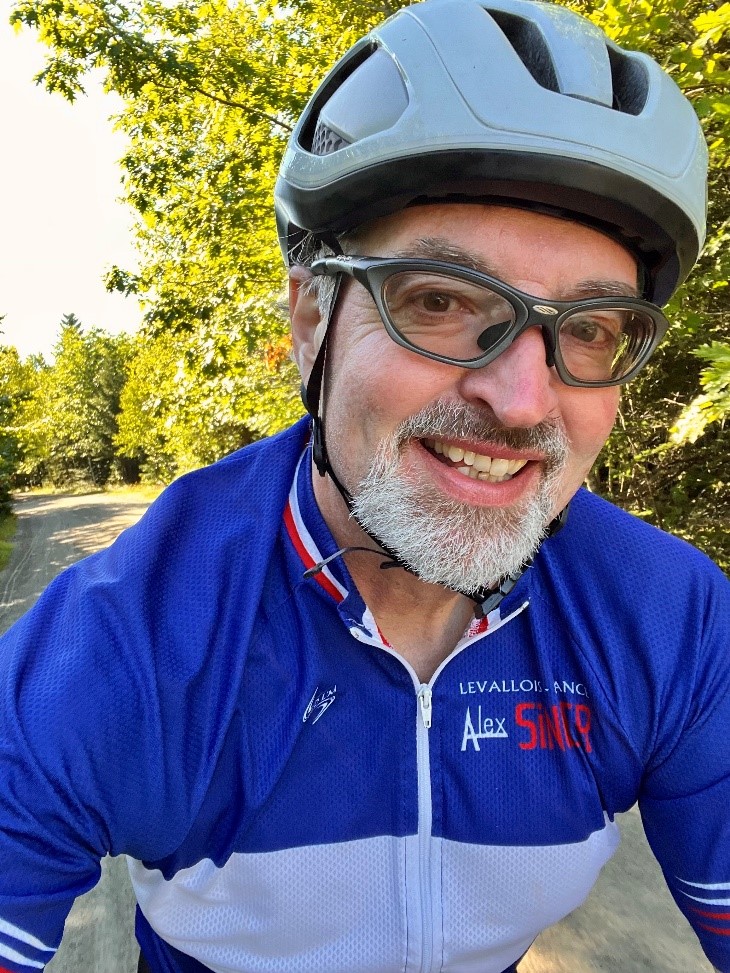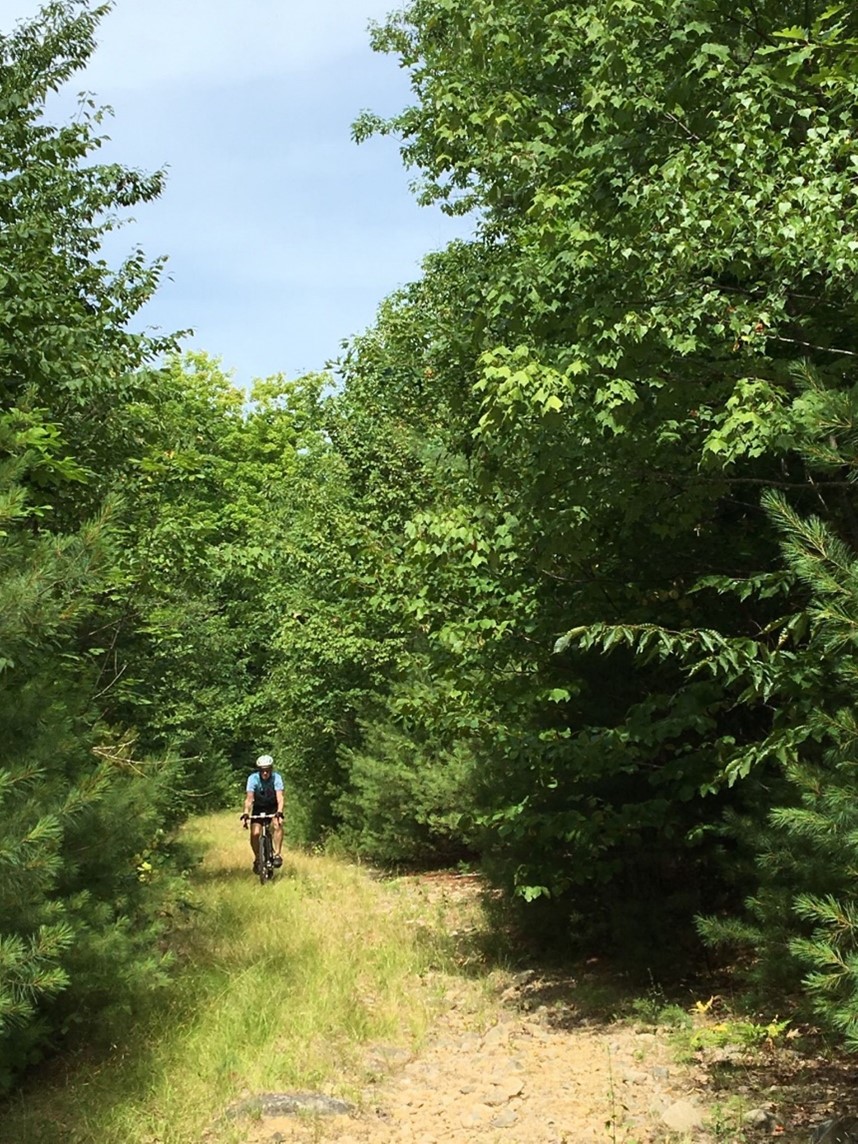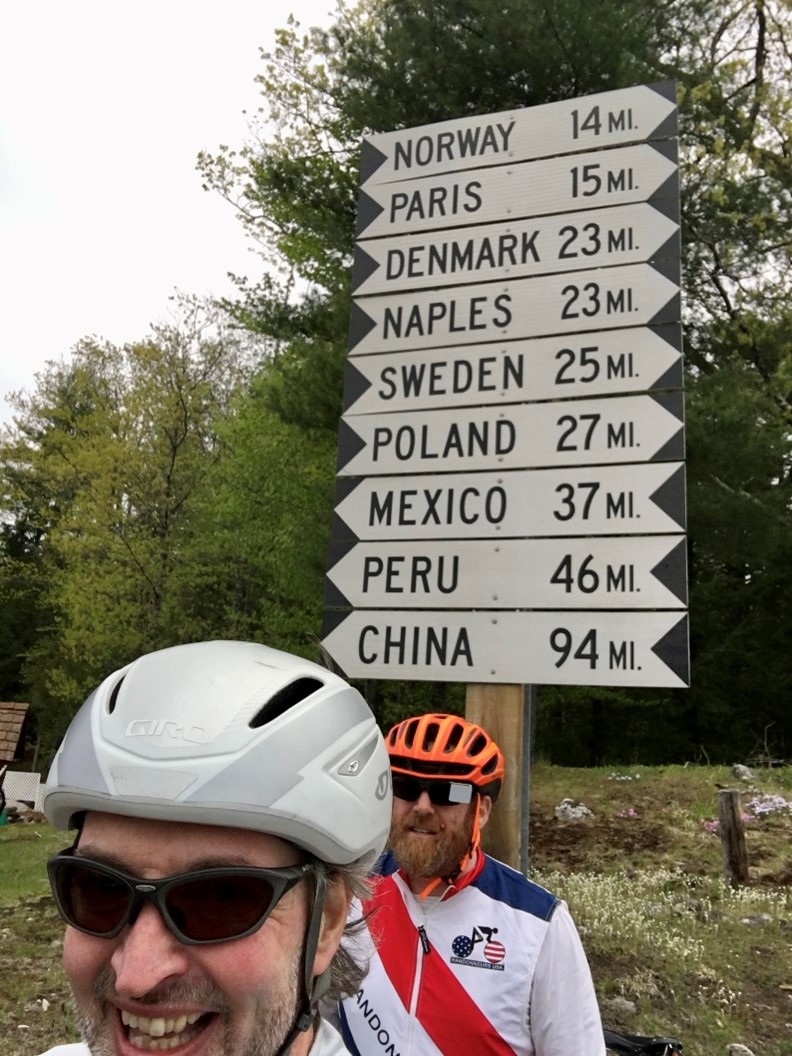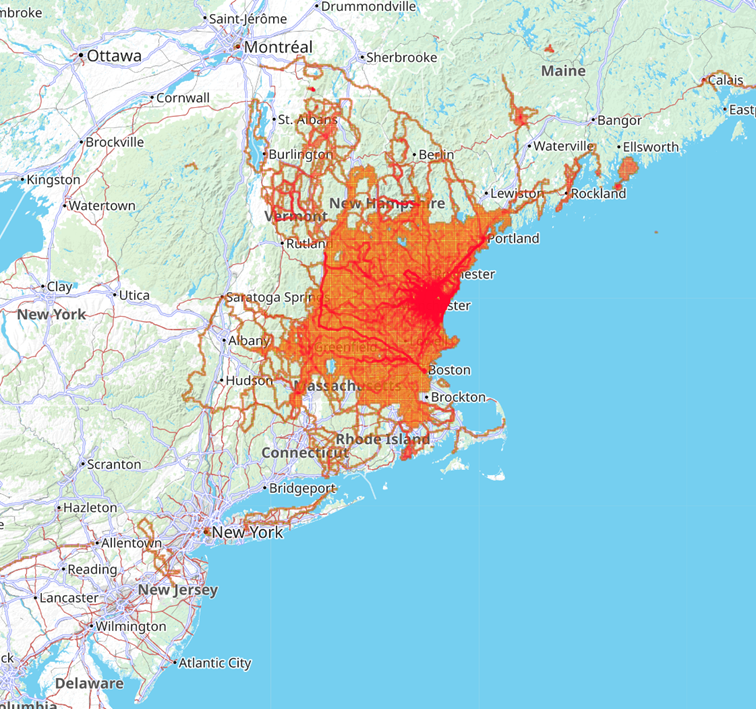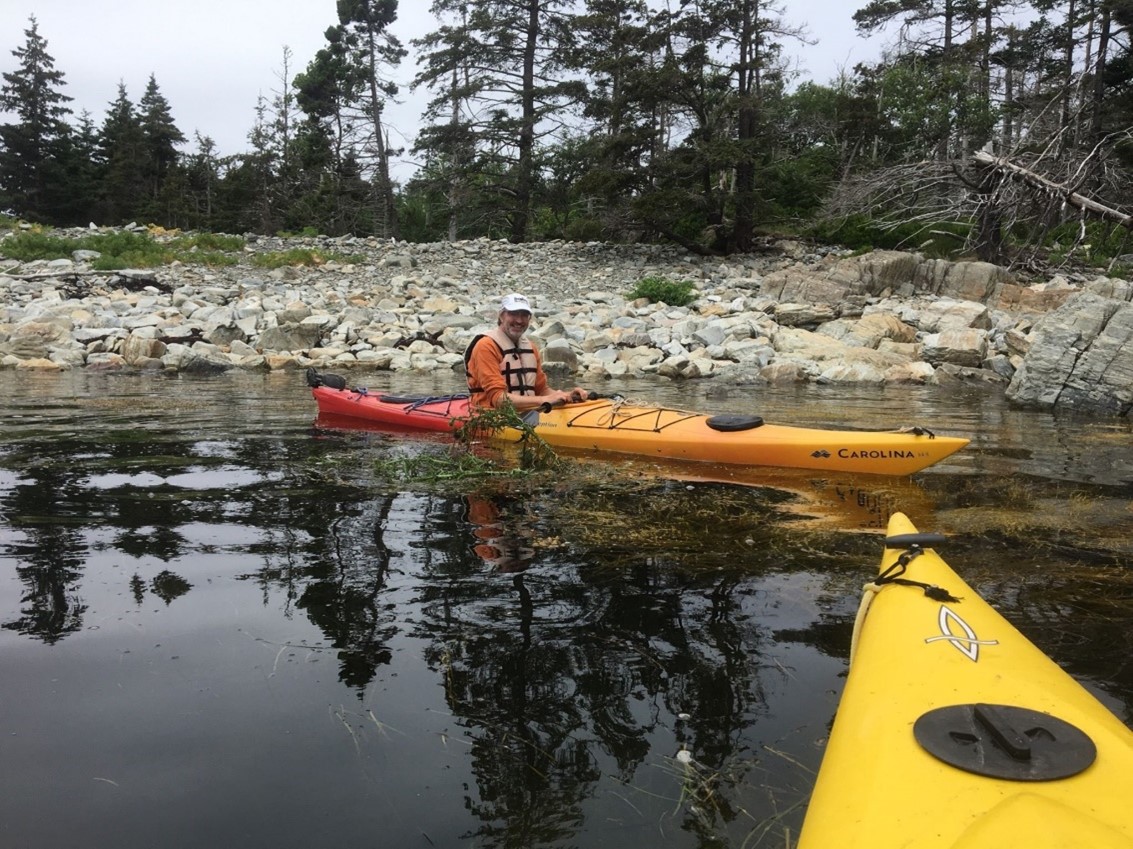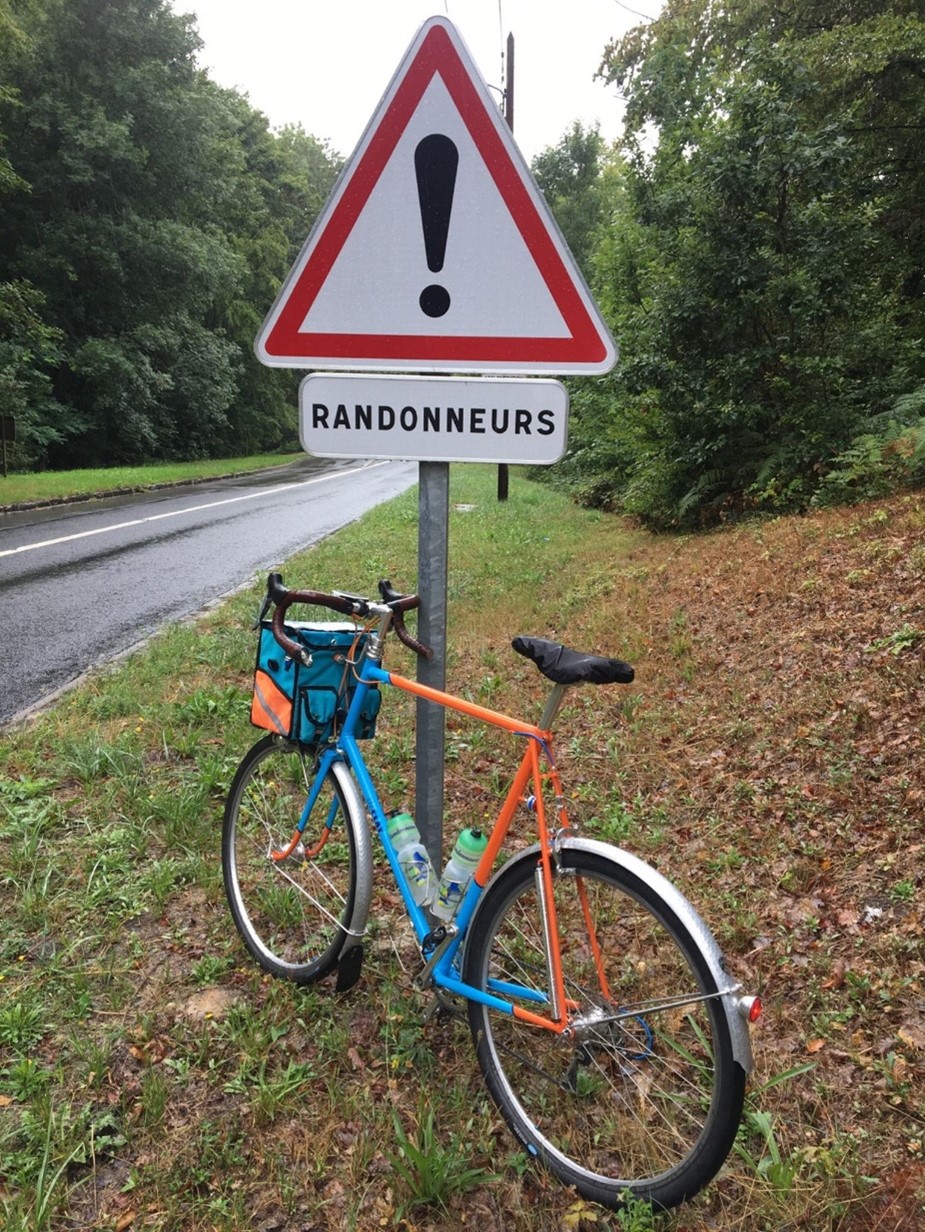Yorick Dix's tiler interviews: Eric Nichols: Keeps on tiling in the new world
This interview first published in the Ride Every Tile Strava group in June 1st, 2023.Eric Nichols, tile explorer since back in the day and author of the brilliant activity title 'Row vs. Wade'. He'll tell us about tiling in the endless woods of New England, mapping, and randonneuring.
Q. Hello Eric, could you please introduce yourself?
Hi, I'm Eric Nichols. I live in New Hampshire, in the northeast US. I've been a cyclist for most of my 62 years. I'm also a map enthusiast. I’ve been called a “map geek” more than once!
Q. There is this guy in the South of England who does all his route planning and tiling with physical maps. Where you ever that enthusiastic?
I love maps of all kinds, but unfortunately there are no paper maps that contain all the details that I need. I'm often looking for a thin spot in the forest that may have been a road or a trail at one time but is not on any current map, and maybe never was. I prefer a large screen where I can bounce from satellite to OSM to Google Street View, etc. Gathering information from multiple on-line sources reduces the amount of on-the-fly rerouting I may need to do during the ride. Sometimes for the difficult tiles I’ve had to find property line maps or maps of conserved land, then create a bushwhacking course that stayed as much as possible on "safe" ground. I recently converted a telescoping carbon fiber hiking pole into a GPS holder, so I could reach through a fence into a mini-tile boundary.
Q. Looking at your Strava ID you are an early adopter? Also in tiling? When and why did you start tiling?
I joined Strava early in its development, around 2011. My activities on Strava extend to the time before Strava! started recording rides on a GPS in 2007 and loaded those previous activities into Strava after I joined.
The personal heatmap feature in Strava was an early motivator for me. I like exploring new roads and trails. Back then, Strava allowed you to view other rider’s heatmaps. I knew other adventurous cyclists in my area, and from their heatmaps I could identify places they rode that I had overlooked.
After VeloViewer was introduced, I quickly gravitated to the Explorer metrics, and discovered that I had already explored many tiles in my area. Thus began my quest to explore every tile in the Northeast US! I discovered that I was the top-ranked explorer in the US and started following other riders on the leader board. I was briefly in the top 3 for max square and cluster, but it soon became impossible to keep up with the Europeans.
Q. Did the way you tile change over time? Were you a fanatic from the start?
I was smitten with tile hunting from the beginning. Tiling provides me with multiple pleasures. I like the planning phase, figuring out how to reach difficult tiles, and how to put together an efficient ride that explores the most terrain with the least effort. Then there’s the ride itself: discovering new places, encountering obstacles that require changes to the ride plan, and the satisfaction of tagging a difficult tile. After the ride, reviewing the data and seeing the accomplishment is yet another pleasure.
Over time, I’ve gotten better at gathering information during the route planning phase. The global heatmaps from Strava, RWGPS, and others have improved. Satellite imagery and Google Streetview have also gotten better. New England is heavily forested, and it can be difficult to see unmapped roads and trails in aerial imagery. It helps to find images taken after the leaves have dropped. These tools make it easier to plan a successful route – one that minimizes bushwacking and trespassing! Even still, I’ve done a lot of the former and won’t confess to the latter.
Q. Did you ever get in trouble over things you will or will not confess to? Any close calls?
Yes, many close calls! Most states in the northeast US have right-to-pass laws, which makes it legal to cross private property on foot unless it’s signed against it. Many old, abandoned roads are still public rights-of-way but the abutting owners may not know of that right, or accept it. When I'm on a tiling mission that takes me off public roads, I tend to be quiet and unobtrusive to avoid being noticed or raising suspicions. No squeaky brakes or loud riding companions.
A few times I’ve been stopped by landowners in awkward locations. Depending on the tone of the interaction, I’ll either say I’m lost, blame my GPS, and apologize, or explain my mission (simplified) and ask for permission to continue, etc. Only once did I have to turn and run while the angry landowner said he was going back in the house to get his gun!
The nice thing about the VeloViewer Level 14 tile is that it is relatively large at about one mile square. There is often more than one way to get in, even if it involves more bushwhacking.
Q. How is tiling in New England? What difficulties do you encounter? Any wildlife to be afraid of?
New England is one of the better places in North America for tiling. The towns are relatively closely spaced, and even the rural areas often contain a network of roads and trails. There are relatively few large expanses of inaccessible property. The challenges are mostly in the mountainous areas, where it can be difficult to access some tiles by any means. An all-road or gravel bike is the best tool for tagging tiles in my area, since many places are only accessible by dirt roads or paths. I've used many types of activities to expand my explored area, including hiking, fat biking across frozen lakes, Nordic and alpine skiing, and kayaking. A typical tile ride for me might involve a mix of paved roads, dirt roads, trails, and times when I stash my bike in the woods and take short hikes.
Though New England is relatively populated and settled, it can be rural and wild away from cities. In the past ten years I’ve encountered about 10 bears during my explorations. The bears in my area tend to be small and shy so most of those encounters were brief and enjoyable. One time I was tagging tiles in a remote area, pushing my bike down a rough trail near a place called Bear Pond. I encountered a mama bear and three cubs. The mom and two cubs ran to my right, the third cub went up a tree to my left. I was between the mother and her cub! I very slowly backed down the trail a safe distance, and eventually the cub climbed down and ran to its mother. I kept going and got the tiles.
Q. You have a decent cluster (9500+ tiles) and square (63x63). Any plans on seriously increasing those?
Max square no, cluster yes! My max square is at its practical geographic limit. One side is next to the Atlantic Ocean, the opposite side is against a large private hunting club that keeps exotic game behind a 30-mile-long fence.
Unlike my max square, my tile cluster can be expanded almost indefinitely. It currently extends into seven states. My goal this year is to reach 10,000 tiles, and eventually I’d like to extend into Canada and complete all accessible tiles in my home state. As any tile enthusiast knows, progress slows down as the edge of your explored area gets ever farther from home! It’s currently a two-hour drive or an all-day bike ride to the edge of my explored area. To help to reduce the impact of driving to these new explorations, I use solar power to charge an electric vehicle.
Do you have a special tile of which you have special memories? Any tile which took extraordinary efforts to reach?
There have been so many! One that stands out was a tile I tagged with Pete Bartlett from the UK, the curator of Ride Every Tile, an accomplished tiler, and the person who first defined the tile cluster. Pete and his family were staying in a waterfront hotel about 30 minutes from my home. The hotel stands on a point of land that touches an offshore tile. That tile could only be accessed by hotel guests. I met Pete for the first time, we tagged that tile, then went on a nice ride and tagged a second tile further up the shore. Neither tile was difficult but getting them with the aid of a fellow enthusiast made it special. We continue our friendship and have visited each other several times.
To get the final tile to complete my current max square, my wife and I kayaked a large lake. That was a special activity because I was fortunate to share it with my extremely tolerant and understanding wife.
Q. Tiling brings us to the most beautiful and weird places. What did you discover because of tiling, what you otherwise never have known?
That private hunting park I mentioned is a good example. While I don’t expect to ever get inside, I’ve gathered as much information about it as I could find, a difficult task because the park is secretive. I've explored the perimeter, which is remote and very beautiful. While exploring near the park I heard elk inside the fence, making bugle sounds. Such a beautiful and eerie sound! I learned that the park has an interesting history. In the 1800s, they kept a herd of buffalo. During that time, wild buffalo were driven to extinction. The buffalo from this park were used to repopulate the American West.
Q. You are an enthusiastic randonneur. What is it about it that you like so much?
I enjoy long days on the bike, riding beyond the horizon and pushing my limits. I first rode 200 miles at age 14 so I guess becoming a randonneur was almost inevitable. A good brevet is like a long meditation, lots of time to just be in the moment. I also enjoy seeing new places, and randonneuring provides plenty of opportunities for that. I rode Paris-Brest-Paris in 2015 and 2019 and hope to ride it again this year.
Q. Do you adapt your brevet rides to pick up extra tiles here and there?
Yes indeed! I often make short deviations during brevets to tag new tiles. Many of my randonneuring friends have come to expect this eccentric behavior from me.
Q. On your activity map I can see that you’ve done rides all over the United States. Do you experience any differences in road culture?
Road manners vary everywhere, so it’s difficult to generalize. Overall, road manners of drivers toward cyclists are pretty good in the Northeast and somewhat less good in the Southeast. In general, where bikes are more numerous, road manners tend to be better. Most people are courteous everywhere, most of the time.
Q. You’ve been cycling in Europe too. Any observations you would like to share with us?
I’ve worked for engineering companies headquartered in Paris and Amsterdam, so I’ve been fortunate to ride in many places around Europe. Riding in Europe is a different and generally more pleasant experience. Motorists seem much more accustomed to driving on narrow roads and sharing space with other road users. Cycling infrastructure is often better developed, which further enhances the experience. Some places in the US have made significant improvements, but none are at the level of the Netherlands, yet!
Q. Are you ever fed up with tiling? Have you ever cancelled rides when already started?
I never stopped a ride when started, but I sometimes skip a whole day mostly because of really bad weather. Tiling is fun for now, but it’s gets harder when the cluster grows. I don’t like the travel to the start of my ride. And those journeys are getting longer and longer. Maybe bike-packing holidays are an option in the future, if I can get my girlfriend interested.
Q. What extraordinary feats of other tilers did you notice?
Jürgen Knupe’s cluster from the Baltic to the Mediterranean is mind-boggling. I continue to be astonished by Jonathan France, who built a 100x100 square in a single year.
Q. In your surroundings, has anyone started tiling because of you?
Yes, I've infected a few people with the tiling bug, mostly other randonneurs. One might think it’s because they ride a lot, but I think they do it mostly to get me to shut up about the joys of tile hunting.
Q. Any ideas on the whole concept of tiling? Any possible improvements you are thinking of?
Between regular tiles, mini-tiles, and Wandrer.earth miles I think the palette of exploration options is relatively complete. I also find motivation through various randonneuring goals and enjoy seeing my Eddington number increase, slowly.
I initially questioned the benefit of other tile sizes, but soon discovered that zoom level 17 mini-tiles (a.k.a. Squadratinhos) are a fun local pursuit. I spent much of last winter expanding my mini-tile cluster north into Maine and south into Massachusetts.
I think riders should share their data if they want to be included on the leaderboards. I like to see what people do and learn from them.
When I travel to a new place I will usually try and build a small local cluster or local max square. It provides some structure to my tourism and often results in unexpected discoveries. My family is generally tolerant of my need to explore... to a point.
Q. In whose story would you be interested?
Yours, Yorick! And Stefan Lenk. Also Brian Toone. Brian has more miles than anyone on VeloViewer, and the largest number of tiles in North America. With a little work he might be able to create a very large cluster and square and push me off the North American podium.
Eric's vital statistics
Max square : 63 (leaderboard and public data)Max cluster : 9476 (leaderboard and public data)
All tiles count : 22488 (from leaderboard, 22444 from public data)
Rarity weighted : 61522
Average tile rarity : 43.5
Home region: United States
Eric on Strava
Eric on Veloviewer
